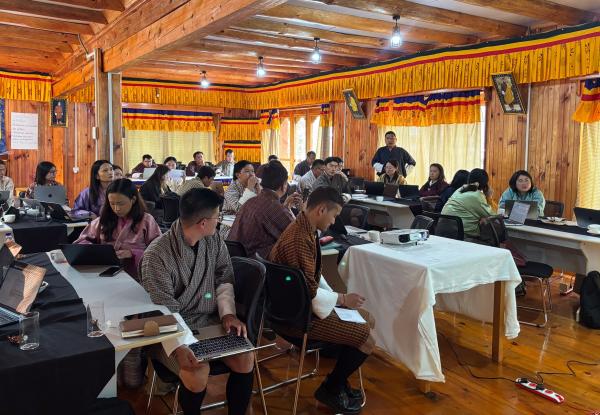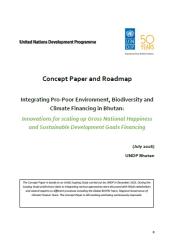Bhutan
Geographically, Bhutan forms the part of the Eastern Himalayan Biodiversity Hotspot. Forests is the dominant ecosystem in Bhutan, with 70.46 per cent of the country under forest cover and an additional 10.43 percent under shrubs. The total protected forest areas in the form of national parks, wildlife sanctuaries and biological corridors corresponds to 51.44. Further, as a result of variance in the altitudinal range, with corresponding variation in climatic conditions, the country can broadly be divided into three distinct eco-floristic zones with different forest types. Agro-ecologically, Bhutan has six zones with different altitudinal ranges and climatic conditions, with zone relevant agricultural practices. The aquatic ecosystems of Bhutan consist mainly of rivers, lakes, marshlands and hot springs. Bhutan records more than 5,600 species of vascular plants out of which approximately 94 percent are native species and about 144 species are endemic to Bhutan. More than 200 species of mammals are identified with 27 of them are globally threatened. Further, Bhutan has recorded 728 species of bird till date, of which, 18 are globally threatened. Surveys of other lesser-known species such as fungal diversity, herpetofauna, invertebrates are ongoing.
Bhutan revised its National Biodiversity Strategies and Action Plan (NBSAP) in 2014 ensuring full alignment with the Global Aichi Biodiversity Targets under the UNCBD. Bhutan also revised its National Action Programme in 2013 drawing on the national objectives of environmental sustainability and the UNCCD objectives. The government is also implementing climate change adaptation and biodiversity conservation projects through various financing windows such as Global Environment Facility (GEF) to combat climate change issues in the country.
- BIOFIN Bhutan reviewed more than 40 policies, legal instruments, and strategies; a comprehensive assessment of existing policies and regulations using a biodiversity lens also determines implications for climate investments and financing.
- BIOFIN Bhutan pioneered in integrating BIOFIN and CPEIR processes and attempted the first integrated approach to Biodiversity and Climate Expenditure Review, resulting in a Framework that can track biodiversity and climate expenditures on a periodic basis
- Informed a policy dialogue on Innovative Finance, demystifying the concept of innovative finance and ideas for Bhutan’s Round Table Meeting
- Demonstrated ecotourism as a feasible financing solution, demonstrating its economic impacts and generating an independent project.
12 August 2025
8 January 2025
The Royal Government of Bhutan prioritized three Sustainable Development Goals (SDGs): SDG 1 (End poverty), SDG 13 (Combat Climate Change.) and SDG 15 (Protect Ecosystems and Biodiversity) to demonstrate medium-term results. At the same time, it is preparing the nation’s 12th Five Year Development Plan. Given the priority of the Bhutan to understand how to finance the implementation of the 12th Plan while delivering SDG results, BIOFIN was invited to pioneer an integrated approach to development financing. Following BIOFIN steps and other related initiatives, the combined Policy and Institutional Reviews confirmed the case, as biodiversity and climate related policies and regulatory frameworks are mostly overlapping for Bhutan. This was followed by an integrated Biodiversity and Climate Change Expenditure Review that provided biodiversity and/or climate related expenditures including a breakdown of poverty-related expenditure as it relates to climate change and biodiversity expenditures. The Finance Needs Assessment for Biodiversity attempts to relate to country’s Nationally Determined Contribution where feasible. The proposed financing solutions would help amplify the impacts of isolated interventions on biodiversity, climate change and poverty reduction. For example, climate-smart conservation of biodiversity and ecosystems can help people to escape from poverty as well as adapt to climate change. It enhances the ambition and scope of Bhutan’s resource mobilization horizon and reinforce Bhutan’s political and technical leadership in sustainable development.

